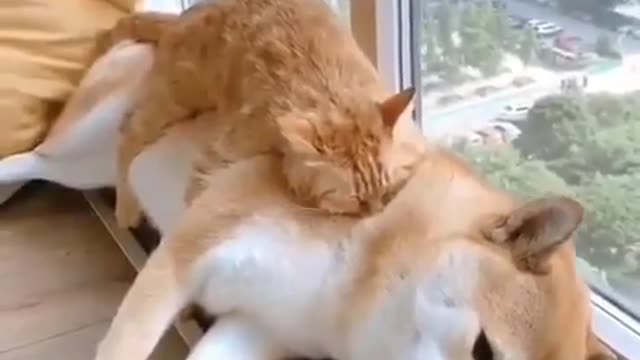Premium Only Content

how cute this
دددددددددددددددددددDogs and Cats Living Togetherددددددددددددددددددددددددددددد
Dogs and cats are supposedly life-long enemies. Hence the phrase, "fighting like cats and dogs." Having always owned both cats and dogs, I find the phrase and the premise to be far more inaccurate than accurate. Of course, we all know that there are those dogs that will simply chase every cat they see and those cats that will never tolerate a dog. However, it has been my experience that handled correctly, the vast majority of dogs and cats can live together. They may not learn to love each other, but they certainly can learn to tolerate each other's presence. Dogs and cats that are raised with each other typically do fine their entire lives. They may actually accept an animal of another species more easily than one of their own, in that there are fewer fights over dominance and territory.
There are some dogs that should not be kept with cats. Dogs with a strong hunting heritage may always view cats as prey and may never be able to be trusted with any small animals. In addition to hunting dogs, terriers such as Jack Russells and Pitbulls are often poor companions for cats. These dogs have an incredibly strong predatory instinct; they chase and attack moving objects without thinking about whom or what the object may be. Cats and other small pets are just too much of a temptation for these dogs.
Other dogs respond less to the animal than the situation and will leave alone a cat that sits still, but chase and attack one that moves. This is especially true of dogs that are kept outside. There is something about being out of the house that really pushes the hunting instinct into overdrive and will often result in even the most docile indoor dog attempting to chase cats once outside. So, one would not want to make the assumption that a cat and dog who tolerate each other indoors will do the same outside. The dog may decide to attack the cat. Finally, dogs that have a history of attacking cats are likely to do so again and should not be trusted with cats. If you are planning on rescuing a previously-owned dog, it is a good idea to get a history of the dog's attitudes and behaviors around cats before bringing it into a house with cats. Many shelters will allow you to 'test' the dog by introducing it to a cat before completing the adoption.
Most cats, if they have had positive experiences with dogs, will tolerate canines in the house. Those that will not typically have had some prior negative interaction that is firmly embedded in their memories. Because most cats, even those that hate dogs, do not attack without provocation, these cats may be able to live with a dog. However, they probably will never bond with the dog, will avoid the dog at all costs, and will be pretty miserable. It is kinder to leave these cats in a feline-only household. Again, it is often possible to find out the history of a cat before adopting it or to test the cat's reactions to dogs in an adoption situation.
So which cats and dogs can get along? The answer is just about all of the rest of them. In the best of circumstances, cats and dogs really become friends, playing and sleeping together. In other situations, cats and dogs may never be overly friendly, but they can learn to tolerate and behave themselves with other members of the family, including those of other species. As long as you are willing to work out a positive introduction and protect the animals from physical harm, these species usually get along. The process may take up to six or eight weeks, or even longer, but can be successfully accomplished.
If you are thinking of bringing a cat into a dog household, or vice-versa, there are steps that you can take to ensure the success of the relationship. First, because a dog can kill a cat, safety is your first concern. The dog needs to be able to be kept separated from the cat. This can be accomplished with a crate or a separate room. The dog should have a refresher obedience course, so that it will sit, stay, and come to you when told, and leave the cat alone if ordered to. The dog needs to remember that the people, not the dog, rule the house. This way you can 'explain' to the dog, if necessary, that the cat is yours and needs to be treated with respect. In addition, the cat needs to have a safe haven. This means that the cat's food and litter boxes need to be inaccessible to the dog and that the cat has places to run and hide. For example, leave a few bookcase shelves empty so the cat can climb to them, put a cat door into a closed bedroom, or use baby gates to separate the dog from the cat's own room.
I keep my cats' litter boxes, toys, scratching posts, water, and food in an extra bedroom. I use a baby gate to keep the dogs out of the room. I have cut a small cat-size opening into the closed mesh of the gate so that the cats can dash through it if necessary and not have to leap the gate. My dogs respect the gate, but if you have dogs that leap over it, you may need to cut the cat door into the room door or install a screen door with an opening large enough for the cats.
The initial meeting and first few weeks are critical times to set the tone for the future, so it is important to make all introductions go as smoothly as possible. The key is to remember that these animals will be together for a lifetime; there is no reason to rush their meetings. If bringing a cat into the house, provide the cat with its own bedroom for the first few weeks or longer. The litter box and food should be placed in this room. The dog in the house can smell the cat under the door but has no real need to meet the new member of the family until the cat is comfortable and bored with its personal space. If this is a young kitten, they may end up living in this room for several more weeks. Once the cat is doing well in its own room, you can let the cat explore the house, undisturbed by the dog. You can actually put the dog in the cat's room while the cat is out so that the dog really gets to experience the cat's scent without bothering the cat. You can also get the pets used to each other's scents by swapping toys, towels, or other items between them.
The initial face-to-face meeting should be done after the new cat is familiar with the entire house. Make sure that the dog is on a leash and under control. Have another person near the cat to provide help if needed. Keep the meeting short and positive. Praise the dog for being wonderful around the cat. Use food rewards if appropriate and make sure that the dog understands that good thing happen when the cat is present. After a few, short positive meetings, it is time to let the cat explore for longer periods, with the dog present and on the leash. If this step proceeds calmly, let the dog off the leash and watch the interactions. Make sure you are always there to stop any problems before they can accelerate. Do not allow the dog to be aggressive in any way to the cat, and lavishly praise the dog for good behavior. Be certain that the cat has access to hiding places. If aggression occurs at any stage of the introductions, return to the previous stage and slow down. Even if all looks great, do not leave the cat alone with the dog until you are truly positive that everything is running smoothly. This means that if they cannot be supervised, the cat should be left in its bedroom or the dog kept crated.
Bringing a dog into a cat household is relatively easy. The dog should be kept on a leash for the initial introductions and never left unsupervised. Make sure that all animals are praised for their wonderful behavior when they are together. As previously discussed, the dog can be crated or the cat left in a bedroom when they cannot be watched. Since the cat is already familiar with its territory and the dog is a newcomer, the dynamics of the relationship often turn in the cat's favor, making the transition relatively easy.
Puppies and kittens do present unique challenges. Kittens must be protected from dogs at all times simply because any dog is big enough to badly hurt or kill a young kitten. A kitten must always be closely supervised even around the best behaved of dogs. Provide the kitten with appropriate toys of its own. Do not let the kitten 'play attack' the dog or chase it. This can rapidly escalate into a dangerous situation. For the same reason, do not let the dog 'play' with the kitten. The kitten must be kept in a safe room when an adult is not home. My kittens stayed in their own room when I was not at home and at bedtime until they were approximately six months old.
Rambunctious puppies may also be a problem. Without meaning to, an energetic puppy can harm a kitten or even an adult cat. It is up to you to make sure that their interactions are monitored so that no one gets hurt. It is also really important to exercise and play with the puppy routinely. Make sure the puppy has its own toys and uses them. A tired puppy is less likely to bother the cat and less likely to be a behavior problem in the house.
It takes work, patience, and time to introduce cats and dogs to each other. However, the positive outcome is well worth the work. My cats and dogs play, eat, relax, and sleep together. I get tremendous pleasure watching them. You will be pleasantly surprised how much positive energy is brought into your home by having both cats and dogs living there.
-
 2:53:01
2:53:01
Jewels Jones Live ®
1 day agoA MAGA-NIFICENT YEAR | A Political Rendezvous - Ep. 103
40.5K19 -
 29:54
29:54
Michael Franzese
8 hours agoCan Trump accomplish everything he promised? Piers Morgan Article Breakdown
67.7K43 -
 2:08:19
2:08:19
Tactical Advisor
12 hours agoThe Vault Room Podcast 006 | Farwell 2024 New Plans for 2025
152K11 -
 34:12
34:12
inspirePlay
1 day ago $4.64 earned🏆 The Grid Championship 2024 – Cass Meyer vs. Kelly Rudney | Epic Battle for Long Drive Glory!
60.2K8 -
 17:50
17:50
BlackDiamondGunsandGear
9 hours ago $1.18 earnedTeach Me How to Build an AR-15
36.4K4 -
 9:11
9:11
Space Ice
1 day agoFatman - Greatest Santa Claus Fighting Hitmen Movie Of Mel Gibson's Career - Best Movie Ever
99.6K42 -
 42:38
42:38
Brewzle
1 day agoI Spent Too Much Money Bourbon Hunting In Kentucky
65.3K12 -
 1:15:30
1:15:30
World Nomac
18 hours agoMY FIRST DAY BACK in Manila Philippines 🇵🇭
49.5K9 -
 13:19
13:19
Dr David Jockers
1 day ago $10.13 earned5 Dangerous Food Ingredients That Drive Inflammation
70K17 -
 1:05:13
1:05:13
FamilyFriendlyGaming
1 day ago $15.59 earnedCat Quest III Episode 8
125K3